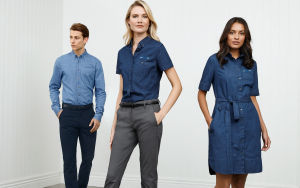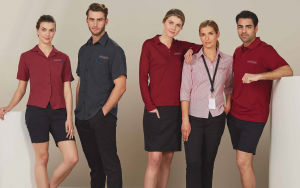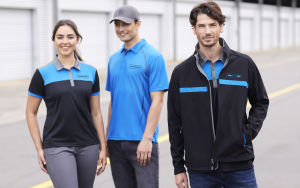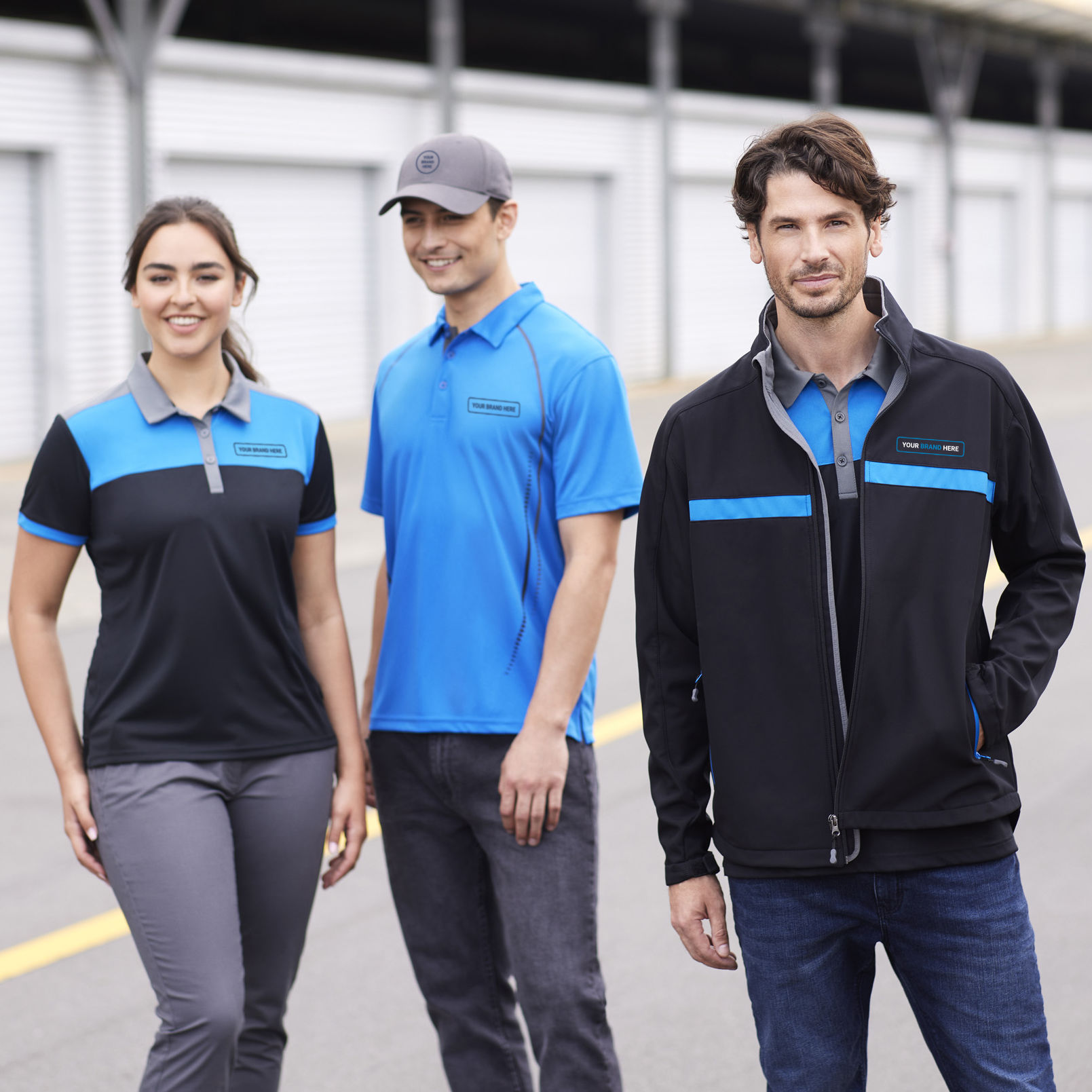With brand image and customer service initiatives taking centre stage in today’s business world, companies increasingly recognise the importance of a well-designed uniform. Not only as a means of identification and professionalism, but also as a powerful branding tool.
In this blog post, we explore the evolution of office uniform design ideas, current design trends in staff uniforms, valuable tips for designing your own uniform, key features to consider, and examples of successful business uniforms that customers would recognise anywhere. If you’re ready to enhance your customer service, team identity and branding, to name a few advantages of implementing corporate apparel, let’s dive in.
Evolution of Corporate Uniforms
Corporate work uniforms have a fascinating evolutionary journey that mirrors the changing landscape of the workplace and progressive societal norms. Let’s delve deeper into the transformation of corporate uniforms throughout history.
1. Early Days: Establishing Authority and Hierarchy
In their infancy, corporate uniforms served as a means to establish authority and create a clear sense of hierarchy within organisations. They were often characterised by strict regulations, emphasising conformity rather than individuality. These uniforms aimed to project professionalism and enforce a unified image for companies.
2. Mid-20th Century: Formality and Professionalism

During the mid-20th century, formal dress codes dominated corporate culture. Men donned tailored suits with ties, while women wore conservative dresses or suits—reflecting an era marked by formality and adherence to societal standards. The uniform’s primary goal was to project a professional image while maintaining a sense of decorum in business settings.
3. 1970s – 1990s: A Shift Towards Individual Expression
After the swinging 60s, social dynamics began shifting. The 1970s disco era saw attitudes towards workplace uniforms changing drastically. Employee empowerment movements paved the way for more relaxed dressing norms and increased emphasis on individual expression within corporations.
Companies recognised the importance of allowing employees to showcase their individualism while presenting a united identity for the organisation. Corporate uniforms started garnering personalised touches such as different-coloured coat collars (lapels) or accessories that offered employees choices within established uniform guidelines.
4. Late 20th Century: From Rigid Dress Codes to Flexibility
Toward the end of the 20th century, many companies reevaluated their dress code policies in response to societal changes. Now, businesses are beginning to truly embrace a more casual attire known as “business casual.” This shift reflected an evolving understanding that employee comfort could positively correlate with productivity.
Workplaces recognised that strict dress codes may hinder creativity and innovation while also hindering employee morale. Corporate uniforms became more relaxed, with styles like polo shirts, khakis, or skirts paired with tailored blazers. The focus shifted to balancing professionalism with comfort and encouraging employees’ self-expression within defined boundaries.
5. Modern Era: Balancing Professionalism and Style

Today, corporate uniforms have reached a new level of sophistication by striking a harmonious balance between professionalism, comfort and style. Companies understand that their image extends beyond mere conformity and recognise the importance of projecting an authentic brand identity through their workforce’s attire.
Today’s corporate uniforms often reflect contemporary fashion trends while maintaining a refined aesthetic aligned with the company’s values. Businesses embrace diversity in their dressing norms to encourage inclusivity among employees while still presenting a cohesive visual impact to clients and customers.
Many businesses endorse the modern practice of “casual Fridays”, where employees can dress down, to an extent, on Fridays! While this is a great concept, it’s extremely important for employees to be mindful of what’s appropriate for a work environment. Avoid denim with rips and offensive t-shirts!
Office Uniform Design Trends

Designing new uniforms that are both functional and fashionable can be challenging. However, staying up-to-date with current design trends can provide valuable insights into creating a modern and visually appealing look for your workforce. At Payless Promotions, we have all the insider knowledge on trending uniforms and can help businesses establish their preferred look.
Here are the current trends of 2023 to keep in mind when designing your corporate business uniforms:
Minimalism with Impact
Clean lines, minimal embellishments, and refined silhouettes are all the rage in modern office wear. Embrace simplicity while incorporating details that make a statement – such as interesting textures or unique colour combinations – to achieve an elegant yet impactful look.
Sustainability Matters
The demand for eco-friendly practices extends beyond product manufacturing into corporate apparel choices as well. Opt for uniform materials that are sustainable or recycled without compromising on quality or aesthetics. Materials like bamboo and linen or even recycled cotton are great options.
Customisation Reigns Supreme
Personalisation is vital when it comes to corporate uniforms and sublimated uniforms offer an innovative solution. With the endless customisation options that come with sublimation, you can truly make a one-of-a-kind uniform that your employees will love.
Allow employees to express their individuality through small details like cufflinks, scarves, or accessories that complement the uniform design while promoting a sense of pride and ownership.
Innovative Fabrics: Performance and Comfort
Innovative fabrics are revolutionising office uniform design by combining performance-enhancing features with ultimate comfort. These fabrics let employees feel comfortable while looking polished, even during those tiresome and long-winded working days.
Moisture-wicking materials keep individuals cool and dry throughout the day, reducing discomfort caused by sweat. Wrinkle-resistant fabrics ensure that uniforms maintain a neat appearance without requiring constant ironing or maintenance.
Additionally, stretchable materials provide better freedom of movement for tasks that require physical activity or flexibility. This enhances both productivity and comfort in various work environments.
Colour Psychology: Creating Impactful Impressions
Did you know colour plays an integral role in our emotional responses and perceptions? Incorporating colour psychology into your office uniform design can create impactful impressions on employees and clients/customers.
For example:
- Blue conveys trustworthiness, professionalism, and stability.
- Green symbolises growth, balance, and harmony.
- Red signifies energy, passion, and confidence.
- Gray represents neutrality and sophistication.
- Yellow evokes optimism, creativity, and positivity.
You can create a visual identity that resonates with the intended audience by carefully selecting colours that align with your brand values and desired emotional impact. So, what colour uniforms suit your business best?
Tips for Designing a Corporate Uniform

Creating a practical and visually appealing corporate uniform requires careful consideration and planning. We have some insider tips to guide you through the process.
Understand Your Company’s Identity
Before diving into the design process, you must clearly understand your brand’s values, mission, and overall intended image. The uniform should align with these aspects while encapsulating your organisation’s one-of-a-kind identity.
Consider Practicality
Functionality is paramount when it comes to office uniforms. Ensure that the design allows for ease of movement, comfort throughout the workday, and flexibility across different roles or departments within your company.
Collaborate with Employees
Take employee feedback into consideration during the design phase. This encourages engagement and builds a sense of unity across the organisation. Conduct surveys or focus groups to gather input on preferred styles, colours, fabrics, and other elements that make individuals feel comfortable and confident in their uniforms.
Balance Style with Professionalism
While incorporating contemporary trends is essential, it’s crucial not to compromise professionalism. Maintain an appropriate level of formality while infusing modern touches that reflect your industry and brand aesthetic.
Key Features of a Powerful Uniform

A powerful corporate uniform goes beyond aesthetics. It is designed to enhance the brand identity, create a sense of unity, and convey professionalism. Here are some key features to consider when planning your staff uniforms:
Cohesive Branding
The uniform should incorporate elements that align with your company’s branding, such as colours, logos, or patterns. This creates a consistent visual identity and reinforces brand recognition.
Versatility
Design a uniform that can be easily adapted to different seasons or occasions. Consider layering options or accessories that allow for flexibility in styling while maintaining consistency in the overall look.
Durability
Invest in high-quality materials to ensure longevity in your corporate uniforms. A durable uniform saves costs on replacements and gives employees a sense of pride in wearing something well-made.
Examples of Successful Corporate Uniforms

Looking at successful examples can inspire ideas for your own corporate uniform design. Here are some noteworthy examples of businesses that have successfully implemented uniforms that can be recognised anywhere:
- Apple: Known for its minimalist aesthetic, Apple’s retail employees wear simple t-shirts or polos with the iconic Apple logo—a sleek and recognisable design that promotes a modern image.
- Qantas: Qantas Airlines’ flight attendants wear professional uniforms inspired by the airline’s long-standing commitment to quality and excellence—a great representation of their outstanding customer service approach within the aviation industry.
- Starbucks: Starbucks baristas wear aprons adorned with distinct green logos, portraying Starbucks’ commitment to quality coffee experiences worldwide.
These examples signify how corporate uniforms can effectively communicate an organisation’s values, enhance customer experience, and contribute to brand recognition.
Final Thoughts

Designing a corporate uniform is a unique opportunity to create a powerful visual identity for your organisation. By considering the evolution of corporate uniforms, modern design trends, practical design tips, and key features, you can create a stylish and functional uniform that represents your company’s culture and reinforces its brand image.
Remember, engaging with employees throughout the design process promotes unity and cultivates a sense of ownership in their appearance. By balancing style with professionalism and staying true to your brand’s identity, you can establish a cohesive and impactful corporate uniform that contributes to employee pride and strengthens your overall corporate culture.
Frequently Asked Questions
Q: How do I style my office uniform?
Consider adding accessories or personalised details within the boundaries set by your company’s guidelines. Small touches like scarves, hats or ties can elevate the overall look while maintaining professionalism.
Q: How can I make my work uniform unique?
Allow some room for personalisation within your company’s dress code guidelines. Small details like different buttons or contrasting trim can add a subtle uniqueness to the uniform.
Q: How do I look classy in my work uniform?
Focus on fit. Ensure that the uniforms are well-tailored to each individual’s body type. This attention to detail will instantly elevate the overall appearance and give off an air of sophistication.
Q: How can I make my uniform more interesting?
Experiment with textures or patterns that complement your organisation’s branding. Consider incorporating pleats, colour blocks, or subtle prints to add visual interest without overpowering the professional aesthetic.
